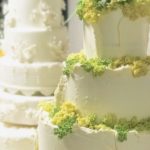
A Royal Elderflower Cake
When Good Day LA called on us to show local home bakers how to recreate Harry and Meghan’s wedding cake, we put out an APB for elderflowers. In true LA fashion, we received a deluge of harvested, foraged and dried elderflowers from backyards and farms from Compton to San Diego. The young royal couple decided on a rather American style wedding cake, forgoing the traditional dense fruitcake for one made by Claire Ptak, a London bakery owner who left Berkeley’s Chez Panisse to follow love in the U.K. The layers of cake are soaked with an elderflower syrup (feel free to switch this out for St. Germain for a boozy version), sandwiched with lemon curd and frosted, ever so slightly for a more rustic look, with buttercream.
Print Recipe
Pin Recipe
Ingredients
Victoria Sponge
- 1 cup Unsalted butter 255g
- 1-1/4 cups Sugar 250g
- 5 Eggs
- 3 Tbsps Whole milk
- 2-1/2 cups All purpose flour 300g
- 1 Tbsp + 1 tsp Baking powder
- 1 tsp Kosher salt
Elderflower Simple Syrup
- 1 cup 240g Water
- 1 cup 200g Sugar
- 1/2 cup Elderflowers
Lemon Curd
- 7 Egg yolks 140g
- 1 cup Sugar 200g
- 1/2 cup Lemon juice, freshly squeezed 120g
- 4 ounces Butter 112g
Meringue Buttercream
- 10 Egg whites 300g
- 2 cups Sugar 400g
- 1 tsp Kosher salt
- 2 lbs. Unsalted butter 908g
Assembly
- 3 Cake layers
- 1 cup Elderflower syrup
- All Lemon curd
- Most of your Buttercream
- 3-4 bunches Elderflowers
Instructions
Victoria Sponge
- Preheat your oven to 350° then cut out three circles of parchment paper the same size as the bottoms of three 8″ cake pans.
- Cream the butter and sugar in the bowl of a stand (or hand-held) mixer fitted with the paddle attachment for about 3 minutes. Turn the mixer off, lift it up and scrape the bottom and the sides well. Beat for a few seconds.
- Add the eggs one at a time, scraping between each egg, until they are fully incorporated. Add the milk and vanilla.
- Mix the flour, baking powder and salt together.
- Add the dry ingredients to the bowl, mixing until just barely combined. Use a spatula to fold in any stray flour rather than beating it longer (which makes for a tough cake).
- Pour between the three cake pans and bake for 25-30 minutes. Remove from the oven and allow the cakes to cool, in the pan, on a cooling rack or over the grates of your stove. Make the syrup.
Elderflower Simple Syrup
- Bring the water and sugar to a boil and wait for the sugar to dissolve. Pour into a bowl to cool down. Once the syrup is just a touch warm, add the elderflowers. The longer they steep in the syrup, the better the flavor! You’ll need to strain the syrup just before using.
Lemon Curd
- Bring a medium pot filled 1/3 of the way with water to a simmer. In a large bowl that can withstand heat (stainless steel is preferred, but tempered glass will work), whisk together the yolks, sugar and lemon juice.
- Place the bowl over the double boiler, turn the heat down to low and whisk continuously until the mixture thickens to a sour-cream like consistency. Keep the double boiler on the stove- you’ll need it for the buttercream.
- Remove the bowl from the double boiler and whisk in the butter. Chill to set.
Meringue Buttercream
- Place the egg whites, sugar and salt in the bowl of stand mixer (make sure there’s no grease in it or the egg whites won’t whip). Grab a clean whisk and whisk and place the mixer bowl into the double boiler. Whisk until the sugar dissolves in the egg whites (our test? dip two fingers into the meringue and rub them together- it’s ready when the sugar granules are no longer gritty).
- Once dissolved, transfer the bowl to the stand mixer fitted with the whisk attachment. Beat on high until the bottom of the bowl feels like room temperature; this could take a few minutes.
- Meanwhile, cut your butter up in small pieces. Once the bowl is cool, turn the speed down and add the butter, a few pieces at a time, until fully incorporated. It might look like cottage cheese for a bit, but just keep beating- it’ll come together!
Assembly
- Flip one of your cakes onto an 8″ cake board or large plate. Fill a piping bag fitted with a plain round tip halfway with buttercream (you can also use a large freezer bag). If you have a cake turntable, great. If not, place this cake board or plate over a flipped over cake pan.
- Using a pastry brush or large spoon, soak the first layer of cake with the syrup.
- Place your piping bag’s tip or opening about a 1/2″ above the edge of your cake. Pipe a border all around the edges of the cake. Now spoon and spread 1/2 of your lemon curd onto the cake, leaving 1/2″ space between the curd and the edges of the cake. Top with the second layer and repeat. Add the last layer of cake on top, soak and chill for 5 minutes.
- Grab an offset spatula or butter knife and spread the buttercream on the sides of the cake, careful never to scrape against the cake, but hover just barely above it. Once the sides are thinly coated, spread a thin later over the top of the cake.
- For a “naked” cake look, take a bench scraper or large chef’s knife and run it, hovering just above the cake, all around the cake while turning it. Top the cake with elderflowers.
Notes
We’ve given you a rather non traditional sponge cake to work with as your base. This cross between an American pound cake and a European genoise is buttery yet light, and though traditionally sandwiched with a bright and fruity jam, we found it the perfect texture for the lemon curd and syrup. If you can make the elderberry syrup below a day before, you’ll get loads more flavor out of it. The buttercream recipe will give you more than you need, but it freezes really well. Thank you to Moonwater Farms, Murray Farms and The Ecology Center for all the flowers!
